#japanese seems to corroborate with this as well
Text


(Text in ALT)
As the two deuteragonist-rivals of the GBA CV games, Maxim's motives seem to be commonly confused for Hugh's;
Hugh's father Morris held the Hunter Whip. As Hugh was more capable than Nathan, he was caught off-guard and became envious and fearful for his self-worth when the weapon was instead granted to Nathan. These emotions caused animosity within Hugh, though it only appeared to come to a violent head within Dracula's castle. Unlike the Belmont's Vampire Killer, the Hunter Whip was not dedicated to one singular bloodline.
Maxim did not want the Vampire Killer, nor did he claim he was jealous* of Juste's position. Following Simon's time, Dracula's remains were to be collected by the next Belmont in a ritual to destroy them; Maxim did this in Juste's place, hoping it could be instead used to free him from his "cursed" fate, likely relating it to Simon Belmont's curse. His possession began during this journey, when he was "led by a higher being" to the remains, though blacked out before he could destroy them. He does clearly say he wanted to be stronger than Juste, though the dialogue immediately following claims it's for Juste's sake and not for his own ego.
Additionally, it is never mentioned in the game's dialogue that Maxim or Juste had any winning or losing streak against one another. Any reference to their "training" is in ending B, in which Maxim claims that the Dracula Wraith is nothing compared to the training the two experienced together.
Both characters appear to feel a sort of worthlessness and/or helplessness in their position, as well as guilt especially following their subsequent possession.
*One might argue that Maxim perhaps holds some jealousy for Juste's position of Vampire Killer. It's up to your own interpretation.
#castlevania#akumajou dracula#harmony of dissonance#circle of the moon#maxim kischine#hugh baldwin#maxim#hugh#cv#mine#text#long post#feel free to correct me if i'm wrong in any parts of this but Shrug#japanese seems to corroborate with this as well
65 notes
·
View notes
Text
Pikmin 4: The Cannon Beetle Mix-Up
As the person who made an entire phylogenetic tree of Pikmin creatures (soon to be updated!), it should come as no surprise that I have a lot of love for this series. With Pikmin 4 introducing a whole new group of critters, while also bringing back many classic ones, I would like to shine a light on one of my favorite enemies: The mighty Horned Cannon Beetle. While this enemy might seem like it caused some confusion regarding its relation to previous enemies, it actually cleared up a few mistakes and inconsistencies from almost two decades ago!
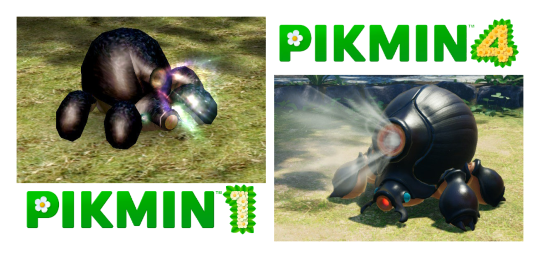
Between Japanese and English languages, each Pikmin enemy gets four different names. This might sound complicated, but I'll try my best to juggle them all and explain their confusing history.
Pikmin 1 introduced the enemy then known as the Armored Cannon Beetle, or Granitus chukkulinae. According to the Enemy Reel:
This migratory lithopod has developed a stronger carapace than its relatives.
Hold on to that information, it will be relevant later. Pikmin 2 then introduced the Armored Cannon Larva, which shares both its name and scientific name with the Armored Cannon Beetle. This is because both enemies share a Japanese nickname (that being (フタクチドックリ, Two-Mouth Tokkuri). However, their Japanese technical name (the equivalent to their English scientific name) makes it clear they are different species.

It's unclear why both enemies share the same Japanese nickname (maybe due to similar designs/mechanics), but it probably led to the mistranslation of the Armored Cannon Larva's scientific name. Their Piklopedia entry states:
This expedition was unable to confirm the existence of any mature lithopods, leading to concerns that the species was extinct on this planet, but the discovery of the creature in larval form eased such concerns.
And for almost two decades, both enemies were generally considered being the same species, which seemed logical at the time, without analyzing their Japanese technical name. Once Pikmin 4 rolled around, it "introduced" the Horned Cannon Beetle. This creature's JP technical name is the exact same as the original Armored Cannon Beetle (Black Iron Giant Stone Wrapper), meaning they are supposed to be one and the same. Their Piklopedia entry states:
[...] this species is actually a naturalized non-native species that migrated here from another continent. [...] Furthermore, it exhibits aggressive territorial behavior, sometimes launching boulders at young Armored Cannon Beetles, which has driven the latter species to the verge of extinction.
This corroborates perfectly with the Armored Cannon Beetle's and Armored Cannon Larva's entries shown previously! So why the name change?
Well I suspect that, when the localizers realized that two separate species had the same name and scientific name, they opted to retcon the older one instead of the most used one. They even added a tongue-in-cheek reference to this retcon by mentioning they were "once mistaken for adult Armored Cannon Beetles".
And that's why the original Pikmin 1 enemy then-known as the Armored Cannon Beetle (Granitus chukkulinae) has been retconned into being a Horned Cannon Beetle (Granitus ferrous).
One image speaks more than a thousand words, so I will end this post with a neat graphic detailing all four different names each creature has. I added the other two mainline Cannon Beetle species for completion's sake. See you guys next time!

38 notes
·
View notes
Text

Oh hey so here's a thing that we never really got proper follow up on, and in fact if anything some late additions to canon just kind of... not quite "contradict" the implicit world building but kind of just exist without addressing the existing hooks?(i hope that makes sense) I'm talking around the subject... I mean the dual zanpakutou and what that actually seems to say about their wielders and how Ichigo absolutely does not fulfill that same criteria with his bullshit final zanpakutou, either played straight or as a subversion.
I have sort of talked about the zanpakutou names themselves but I didn't really stray into the territory of character analysis too much. Kyroraku and Ukitake both have implicit dual personas that are reflected in their swords, at least at first. And Ichigo pretty distinctly doesn't, not in the same way at least, although there is sort of a caveat to that, but I'm already getting ahead of myself...
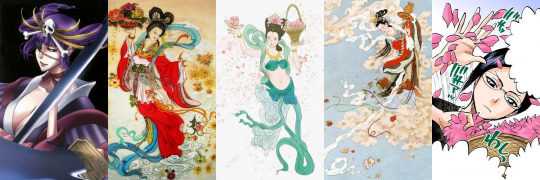
I'll start with Kyouraku since his is probably the least consequential, and the most overtly addressed... On the one hand Katen[花天] probably comes from the more specific Chinese phrase Huā tiānnǚ[花天女], I specify because it has much more concrete artistic associations than [花天] does, either in Chinese or Japanese, and is a minor figure of Chinese celestial bureaucracy often depicted as a beautiful young woman flying thru the heavens scattering flower petals from a bouquet or basket of flowers. The garden she tends is comprised of all the most beautiful and exotic flowers, posses magical qualities such that the fruits of her garden can grant immorality or magical powers, and the petals she scatters all over the world bring happiness and good fortune.
Clearly her evocation here is an allusion to Kyoruaku's outward demeanor as a kind of pampered, decedent lover of good drink, music/poetry, and women. There are a few things in his name that all point to this as well, beyond just his visual design: Kyoraku[京楽] reading as "(Imperial)Capitol + Music/pleasure/comfort" and Shunsui[春水] as "Spring(the season) + Water," the associations with spring somewhat implicitly involving cherry blossoms, making the phrase sort of analogous to "rose water" or "sweet water."

And then Kyoukotsu[狂骨] is a yokai that takes the form of a skeletal old man that haunts the bucket of an abandoned well. It's got some weird uncertain regional etymologies that sort of suggest it could be any of a number of euphemisms, but I'm not certain which if any are relevant to this. There is one i stumbled into that, given the casual nature of all this, i did not think to record like a citation as i didnt think it'd be so hard to track down again... that said it was used as a kind of slang towards a crazy person or a raucous drunk. I don't want to lean too heavily on that when I can't corroborate it, but it did feel like it made a lot of sense: you drink(from a well) something you shouldn't(i.e. cursed) and it makes you violent and/or crazy.
And more over, their release call is,
Hanakaze midarete Kashin naki, Tenpuu midarete Tenma warau
[花風紊れて花神啼き, 天風紊れて天魔嗤う]
"FlowerWind in disarray FlowerSpirit(s) cry, HeavenWind in disarray Tenma* laughs/ridicules."
There is a distinct bit of poeticism here with Hana... ka[花... 花...] referring to "flowers," Ten... Ten[天... 天...] referring to "heaven," midarete[紊れて... 紊れて...] referring to things "in disarray," and kaze... fuu[...風, ...風] referring to "wind." And notably while there are obvious thematic links back to Katen, there's not actually much reference to Kyokotsu, apart from vague tonal implications. Still, the message seems very clear: The pleasant scent of flowers and aesthetic of petals on the wind are disrupted, flower spirits/god(s) cry/wail in pain or otherwise distress. And at the same time, in the same way, a divine wind/winds of heaven, something that is implicitly a blessing or relief, a kind of god send, is disrupted and the evil spirit Mara laughs or jeers. A good thing is spoiled and divine forces make noises of distress and malice.
This just reinforces the names' dualistic themes that suggest there is a dark side to Kyoraku's penchant for unrestrained revelry. While that could be taken a number of ways, the most surface level one would seem to suggest that for all the boisterous drinking and partying he does, he in fact has a violent abusive drunken side to him as well, part some certain point.

Mara btw is a sort of "demon" in buddhism with a lot of associated themes, not the least of which being seduction, and the derailing of one's path towards enlightenment --in Japanese in particular his name is associated with sexual temptation and masturbation, and yeah he's the penis chariot summon in SMT. He is very specifically the giant demon featured in classical art of the samsara --the cosmological wheel of reincarnation within which all living things exist. So when Mara laughs, it's not just a matter of generic evil, it's the victory of base material temptation over enlightenment. By all rights this makes it sound like Kyoraku's shikai is a matter of trading in his easygoing demeanor for a more violent and darker side.
But as we know that isn't quite how things panned out... Rather, the reveal of that very change in tone just got sorta kicked down the road a bit and became a part of his bankai rather than his shikai. But the implicit themes of the zanpakutou's name, and the zanpakutout themselves, suggests that Kyoraku has two swords because he has two truths, two inner selves rather than one: the one that is personified by heavenly flowers, and the one personified by malice and drink.

And I guess just to clarify, I find it really weird that Kubo went and canonized Masashi Kudo's zanpakutou filler arc designs that way he did, and I still sort of regard them and even their inclusion in the manga proper to be kind of non-canon? I know that's a weird bold arbitrary claim, but even as he used the designs they don't feel like they contribute at all to their own theme or shtick. Like, they were clearly designed with no insight to the shikai's actual powers, the designs are nonsensical (the swords printed on her kimono? european oujo drills on a japanese design? the frills on a kimono? the nonsense exposed midriff on kyoukotsu? it's just a mess) they aren't even named accordingly, you'd think the light tone of Katen would lend itself to the shikai's children's game theme and thus the diminutive one of the pair, and Kyoukotsu the darker themes and thus the noh and bunraku theatre thus the older of the two, splitting them between children's play and adult play. But no.
Anyway... that just being part of the set up for the fact that...


Ukitake's got a whole daoist yin-yang thing going on. His theming is a little less obvious at a glance, but pretty distinct in the broader context of things, and eventually ironically nailed down a little more firmly by Kudo's still not especially canon design work for the anime filler: The courtly heian robes the kids are put in are part of the iconic onmyoji image of daoist mystics who served the imperial court as advisors in spite of their non samurai/nobility status. The yin and yang motif is alluded to in the "twin fish" aspect of Sougyo no Kotowari[双魚理]: "Law of Pair(ed) Fish" which is itself later alluded to in the Hell Jaws Wailing/Christening oneshot. Unlike Katen Kyokotsu, there aren't two distinct facets to the sword name, and unlike Kyoraku's katana and wakizashi set, Ukitake has a single sealed katana that splits into two for shikai, all suggesting that the nature of the two fish is that they are a singular unit rather than distinct facets. This makes sense of course because the nature of yin and yang as positive and negative elements is that they are in constant struggle but balanced, and cannot exist without one another.
But the nature of the zanpakutou, again, suggests that Ukitake's soul exists as both sides of that balance, that he is is innately capable of just as much "evil" as he is good. And this underlying tone of something sinister beneath his kindly demeanor is something Kubo sort of tries to paly with but never really fully pulls the trigger on. This theme is where the Fullbringer arc's underutilized bit where Ukitake has been using the substitute badge as a means of surveillance, and where Ukitake is implicitly the one who stripped Ginjo of his powers in the first place, having also monitored him during his tenure as substitute. It implies that, like Kyoraku's two sides to his drink and revelry, Ukitake's inner truth about being an agent of cosmic balance comes in a dark and a light form.
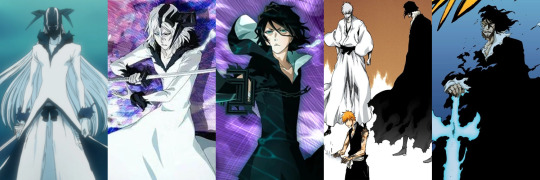
So then there's this thing about Ichigo's stupid new zangetsu(s) where he both has two swords now like Kyoraku and Ukitake, but also doesn't because we get the janky sort of excuse that "oh they're not really two different swords one's just a sheath and their true form is one sword."
And to be fair, while I find the explicit use of that line to try and handwave... i don't know what exactly, but it definitely felt like Kubo thought he was patching up some kind of plothole when he brought it up... we technically already knew that was the case leading up to the first time he addressed it with the final getsuga thing.
In the first inner world fight, the hollow was just a part of Zangetsu that he was able to sort of produce and later reabsorb, and implicitly the opposite was true when the hollow appeared alone during the Visored training: they exist as two sides of the same coin, and can just kind of flip flop control as needed. This made sense as an expression of Ichigo's misguided struggle to deny and rid himself of his hollow --he didn't have two spirits he had one, which again we already knew, but it needed to be confirmed and addressed to cap off Ichgio's arc of self discovery.
Then Kubo tried to sort of rehash this dynamic with the whole the hollow is the sword, and Zangetsu is actually Yhwach's quincy blood just holding the hollow/shinigami side back, but it makes distinctly less sense because when Nimaiya forges the new sword(s) the two spirits show up as separate entities, one per sword. Plus the stupid retconned excuse that, oh no they weren't ever actually the same thing, the whole absorbing thing was just Yhwach actively suppressing the shinigami side. So then what does this really say about Ichigo's nature? Does he have a dualistic nature or doesn't he? Are they two facets of his inner truth, or are/were they always the same singular truth and realizing that was the entire key to self actualization and his true power?
At face value the new explanation divides his identity into shinigami and quincy, despite him having no actual functioning identity as a quincy factionally or culturally, and on a personal level he never actually does anything to reconcile this identity crisis. I know it's a long way around to just point out that it fumbles the theming a lot here, when that was fairly evident even without the context, but I guess I just wanted to bolster that. In the first place i think everyone reading at the time understood it to feel very inauthentic as a twist? like most of the developments of the late arc. Just another case of Kubo phishing around fandom chatter for stupid ideas he could play into to siphon ratings out of.
But again the bottom line being that we had precedent for Ichigo to have two swords in one of two ways: Ukitake's style of having a single identity that encompasses both the best and worst of his inner truth, or Kyoraku's suggested style in which his two facets exist in distinct and separate entities but ultimately both reflect him as truths about his nature. But Ichgio doesn't really do that. His original balance of shinigami and hollow seemed to be a satisfactory solution in the style of Ukitake's, and if he'd just had one shinigami/hollow sword and one quincy sword, that might have been acceptable in Kyouraku's style, but the flipflopping between the two by making the final form just a big sword inside a different big sword where one of the big swords is a sword, but the other sword is just a sheath to hold the first sword(???) is just this bizarre gibberish of themes and symbols.
(I've had this thing sitting in drafts for so long i forgot abotu it. and I swear I had some kind of actual conclusion I was working toward across various rewrites but i don't remember what it was anymore... anyway it's taking up space in my drafts that could be better used, so out it goes..)
13 notes
·
View notes
Note
Is it true that togashi said that he has 3 or 4 stories after the caa ? (if he did please give me the source)
Hello anon!
So, this is a commonly cited bit of info in discussions about HxH. However, after doing some research into the interview it allegedly came from (an interview between Togashi and Oda, the creator of One Piece), I'm uncertain on the legitimacy of this interview.
The mostly commonly cited source for the interview is here, on the HxH Wiki, but it was deleted for some reason. Other Togashi interviews remain up on the HxH Wiki, and I imagine this one was deleted for a reason, possibly because it can't be corroborated.
Here's a poorly-translated version of the interview I found. It could be a result of the poor translation, but the interview itself seems a bit odd to me... Here's another version, slightly different wording but same issues. And here's the French version of it that the other two articles seem to be referencing, which says at the bottom (thanks Deepl): "edit GrM: excerpt from MH from October 2011, no source link to the itw, so until then, to be taken with a pinch of salt and thank you for not leaving in flood."
I'm having trouble finding any scans or photos of this interview in Japanese, which makes me even more skeptical and uncertain. @yyh4ever, do you happen to have any information on this interview and whether it exists or not?
Because Togashi and Oda are both massively popular, I feel like info on a joint interview between them shouldn't be difficult to find. I found this image of Togashi and Oda together, but this doesn't seem to be that interview from what I can make out and I can't find any full versions of that article either. By comparison, Togashi's interview with Kishimoto is all over the place, even on the Viz site (Link 1, Link 2).
If anyone finds a reliable source for this interview between Togashi and Oda, I'd love to hear about it, but for now I would consider this info unsubstantiated! I'm surprised because I previously thought that this was reliable information as well. It's possible it is real, but unless someone provides solid info of its legitimacy, I'm going to assume it's probably fake. It's weird and interesting how much fake information about Togashi exists out there, that's why I'm careful when researching anything people say about him.
Thank you for asking, this sent me on an unexpected research rabbit hole!
43 notes
·
View notes
Note
Ok so I found the original kanji for Geten’s name from the wiki and put it into my Japanese dictionary and

It’s uh… interesting I guess?

ok this is really funny because my first thought was “so if we consider the Todoroki family as the Bible-” and that is a wild thought to be having at 3:04 AM
but yeah in retrospect it seems to be a reference to how he had an unknown origin and people thought he was a Himura/Todoroki for a while but could never be confirmed, which is pretty cool actually
“menat to be read privately” like how geten’s being a himura/the downfall of the himura clan was meant to be a secret ig. leave it to mr compress to extract the tea out of him though we love a gossip girl
“outside code/ceremony/law/rule” fits with that as well like. he’s a fucked up guy and probably a far cry from the noble himura family image, i’ll have to reread his stated backstory to corroborate that though
#bnha geten#geten himura#i did not know this! ty#apocrypha is a cool fuckin word too#sounds like apocalypse#maybe that’s what geten was going for#but redestro was like bruh naming yourself apocalypse?? can you get ANY edgier#and geten was like. ok guess ill name myself the next closest thing *opens dictionary*#bnha manga spoilers#bnha#bnha spoilers#bnha 387
14 notes
·
View notes
Text
i read a theory that ni-ki (noa) is hypnotizing the boys like he did with sunghoon (solon) in fever in order to protect himself and the person explained that he felt guilt doing so which is demonstrated in his solo bathroom scenes and i was wondering if the glitter on the boys’ faces could represent the influence of the hypnotism? maybe him washing his face off is demonstrating him ending it because he couldn’t bear doing that to them anymore, it’s like a physical demonstration of it being over. the part where ni-ki and sunghoon dance together makes me think it represents ni-ki’s ethical dilemma (dilemma….. hmmmm). the focus is likely on sunghoon (solon), because, if my other theory is correct, he has the power to use the other members’ abilities, like with when he copies jake’s (jino’s) fire abilities in given taken as well as in the japanese version of tamed dashed, and in one in a billion he catches the nightball sooha throws, which may imply he is using jay’s (jaan’s) strength powers. so, sunghoon is a greater threat to ni-ki because sunghoon might be able to use it back on him if he finds out.
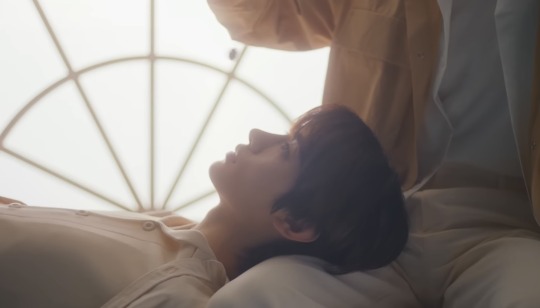

them sitting in the pool with no glitter on their faces may very well be representative of this (+ jay under the shower). also at the beginning, sunoo leaves the bathroom, notice the exit sign.
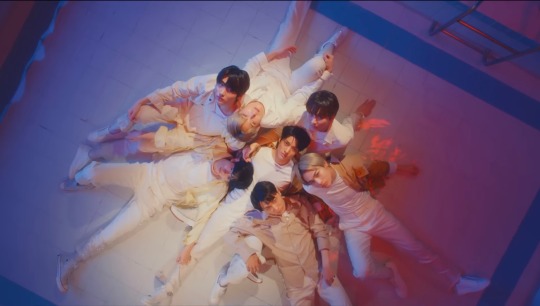


also, i was wondering if the end of that is maybe what prompted the entire fever feelings lol, maybe the inability to feel romantic love is ended if the “spell” (hypnosis) is over, maybe that’s a side effect of no longer being influenced?
i think this makes sense because the ability to feel love like that would definitely be a “weakness.” a liability, if you will. perhaps it has nothing to do with it and it’s just sooha’s strong aura, but this isn’t too far fetched. i don’t think they would necessarily fall in love with others if not for the spell, but that might be an unexpected/unknown/random consequence
additionally, it appears like the object (necklace?) ni-ki used to hypnotize sunghoon is the same object wrapped around sunghoon’s heart later in the video. this is particularly interesting, since it seems to corroborate my idea of how the hypnosis did not allow their hearts to feel love.

i know many don’t think heli feels romantic love for sooha, but i do think so, i also think the fever lyrics are so romantic hahaha then again if that’s not the case then ignore that (the other boys’ feelings, that’s a story for another day)… but judging from what we saw in that flashback to sooha’s arranged marriage in the more recent dark moon episodes, i do think heli really loves her like that (alongside a thousand other examples…. leave me alone i’m vicariously living my y/n life through sooha)
i feel like the paradoxical statements like “please stop, don’t stop” and “release me, embrace me” are reflective of first (or, for the first time in a long time) feeling such a strong emotion. it’s like being told something is impossible and then it happens to you.
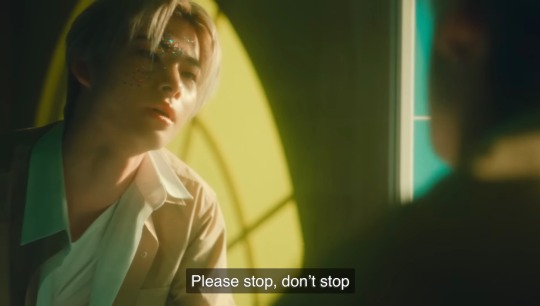

another factor to consider is the timeline….. i think as soon as i have a better idea of when this happens, i’ll go back and check in on the story. the main thing is drunk dazed, i feel like it would be interesting to know whether it’s before or after, but i suspect it may be before (tree scene, anyone?)
i think the darkness at the very beginning (a long time before the rest of the mv) may as well be the hypnosis taking effect. we know ni-ki (noa) can control “the darkness” and i believe the darkness may very well be something which caused the hypnosis. also, the “he shines even in the darkest places” leads me to believe he isn’t affected by the darkness (unless it’s by that vampire leader lady but i don’t remember the details about her attack now)


something i can’t really explain: sunghoon between the doors leading to an altar (is that the throne jake sings about?), with the necklace item in his mouth. also, there seems to be a lot of focus on hands throughout the video. i wonder what that means?
not sure about heeseung’s solo scenes. mostly because my brain fries when i see them but i think it’s either just us being blessed but it honestly might tie into the intense emotion, like when he’s deeply breathing and staring into the camera ??/!/?/? and the curling into a ball, getting up abruptly, etc
#dark moon#dark moon the blood altar#dark moon theory#enhypen#theory#enhypen theory#pls tell me if this makes any sense 🥺#i’ve reached peak nerd#hahahaha#kpop
10 notes
·
View notes
Note
Kadoya: I did not think there existed a universe where we did not exist.
Emu: What do you mean?
Kadoya: It was really surreal.
Kadoya: There is a universe where we exist as concepts in fiction but not really us.
Kadoya: And their fictional heroes are always a sentai team themed after birds.
Kadoya: They heavily resemble the Jetman.
Takeru: Heeeh, I kinda want to see that.
Shoutaro: Why do you think its surreal?
Kadoya: Well their mooks are just Shocker mooks.
Philip: Interesting
Kadoya: I doubt you'll find them in your library, boy.
Sougo: I kinda want to see that.
Ikki: Is it okay to look at that?
Touma: I think its okay.
Aruto: O-kay, o-kiiii! Hai Aruto Ja nai to
*silence*
Shoutaro: Of all the puns, Hiden, that was probably the worst one.
Kadoya: Could we not imitate shocker mooks' sounds?
Shoutaro: it's fine, just don't do it again.
Emu: Why don't you show us a snippet of that world, Kadoya?
Emu: That is if you have some videos of it.
Kadoya: Don't worry, Yusuke took a video or two.
Kadoya: https://www.youtube.com/watch?v=fIq-7jN8ooI
Kadoya: https://www.youtube.com/watch?v=BQMKDzZ5jX8 [until the 1:29 mark of the video]
Huh... well, okay. That was a thing, I guess?
Tbf a lot of other Japanese media reference Sentai and Kamen Rider in some way, just because they are *that* iconic. Can't help but notice some things about this though.
While the bird theme is similar to Jetman, the colors match the Zyurangers, which would be more well known overseas as the OG Power Rangers. Corroborated by Pink having a bow, since that was PteraRanger/Pink Ranger's signature weapon. In the second clip, Pink seems to be calling the shots, which could be a Timeranger reference. Considering when the game came out... not exactly a timely reference, pun not intended.
4 notes
·
View notes
Text
I thought I would air out my thoughts on the Bayonetta situation since Hellena Taylor decided to come back again with another statement. Since gaming news and commentary is the space I will be reporting on soon with my partner in a couple months or so, I thought why not share my take on this since it's been huge news in the gaming space for the past couple weeks...
When I first heard Hellena's initial claim I wasn't too shocked considering that the VA industry has always been shafted in entertainment when it comes to pay. They generally never get any bonuses or residuals so it's always been a industry with little unionized representation (although that has been changing). But when I thought about it for a franchise as established as Bayonetta something didn't seem right...there should definitely be more to the story here than just a flat rate of $4000. So before the Bloomberg and VGC articles came out I asked a source of mine that's pretty knowledgeable about the VA industry in Japan (to get a ballpark for what they might've really offered her since it was a japanese company drafting the contract) and he told me the amount she mentioned did seem a little strange even by Japanese standards for a leading role. So the corroborating articles come out from Bloomberg and VGC, my initial concerns were correct in that she was omitting a lot of information (noticeably with zero proof to back up the claims, considering she already broke the NDA why not outline proof of your claims in the actual contract itself?). So for those that may be aware, the final offer after negotiating was $15-20,000 between 5 different sessions that would've been around 4 hours each. Meaning about a wage of $1000/hr for the role, which to many current union standards in the VA industry is well above fair. Keep in mind that although this was a lead role, Hellena Taylor does not have a prolific history in VA outside of her role as Bayonetta which leads to my next point.
With all this information out there, I find her original statements incredibly disingenuous, especially when she tried to get people to boycott this game. Here are the points of contention I have a problem with regarding Hellana Taylor: 1.) She tried to throw a fellow VA under the bus for taking up the role she decided not to because she thought she was worth more which is incredibly petty and just outright wrong 2.) I believe that VA pay is a serious issue that definitely needs to be addressed but the roundabout way she's trying to start the discussion here considering the circumstances and the information that's out there now regarding this dispute I believe does more harm than good, especially considering she was asking for a 6 figure sum with residuals (while I do believe having residuals in voice-over work should be a given for a any role) 3.) Pissing on her other constituents and developers that worked on this game for the many years it was in development. I find it really selfish, especially in light of the information we have now, that a boycott is justified at all in this situation. I find it really telling that Hellana Taylor had a problem with the pay here when Jennifer Hale (a more much celebrated VA than she is) did not. So all this to say...
In conclusion, Hellana Taylor omitted a lot of information to make her original statement stand out and look good and appeal the twitter mob. There were many debunked claims were really ridiculous like Bayonetta being worth half a billion (lmao). That series barely comes out even, just look at the sales for yourself people. The games barely sell more 1.5 million each release. Let me put it in perspective, it took God of War (2018) selling nearly 20 million units in order to hit the half a billion Hellena Taylor claimed Bayonetta was worth. Want to know Bayonetta's lifetime sales...about 3 million across 12 years. Bayonetta is NOT the huge franchise most people think it is despite its repute in the industry. The franchise barely comes out even each release, which I find it very amusing she keeps bringing this number up, even in recent statement from yesterday. In her recent statement (not surprised if you haven't seen it since it isn't really getting any traction and was just posted yesterday, link here: https://twitter.com/hellenataylor/status/1584415390171480066 ). If you read through and do some critical thinking, it's pretty obvious there's a lot of backtracking being done here, the $4000 magically becomes $15000 like it was reported to Bloomberg, as well as other things. I can understand being disgruntled over pay, but don't drag the team that worked on this game and fellow VAs with you and then claim you're trying to BETTER the industry, that's how change about it. Meaningful change at that anyway, I'm sure it must've been a shock to her since Bayonetta is really the only meaningful role she's done in the gaming industry but she needs to not be vindictive and jealous (which is what I see it as) when someone else takes up your role, what did you think Platinum was going to do when you turned them down twice lol, twiddle their thumbs and just say oh well. But yeah, that's my take on the situation if you have any opinions on the whole situation then please go ahead and share (and keep it respectful).
#bayonetta 3#hellena taylor#game discussion#text#my post#god damn this ended up way longer than i wanted it to be#i did not proofread this so there might be mistakes here and there
5 notes
·
View notes
Note
Here's a bit of oddball trivia: Officially, Pixar lists Chick Hicks' make & model as a '1979 Shyster Cremlin'. Meanwhile, Otis is supposedly a '1972 Shyster Cremlin', and while Fred & his rusty bumper are listed as a 'Stodegy Suaver LT', I'd bet good money that's just a case of badge engineering - he's almost identical to Otis. Do you think that sharing a nameplate (or even family relations) with self-described "lemons" has had some sort of effect on Chick Hicks?
I imagine so! I mean, I feel like his preponderance of stickers also corroborates this. As a race car, the one thing you never want to be is naked--a naked car means an unsponsored car. At the same time, you want to have a primary sponsor--ideally a consistent one, because the more races a primary funds the more consistent their and your brand can be; it suggests a depth of trust in you as a race team, because the sponsor is willing to put some big money behind you.
In NASCAR, the most consistent sponsor right now is probably FedEx, with Denny Hamlin--Hamlin almost aways runs a FedEx scheme, versus say, the 77, which could be running anything from week to week. I watched the last 89 laps of the Nashville race last night and the 77 got pivotal late-race screentime, *I like the 77 and is fellow backrunners* and I still couldn't tell you who sponsored that car. But who was on Hamlin's car? That's right, FedEx.
Chick does have a primary sponsor, obviously--Hostile Takeover Bank. But it seems like Chick also got a lot of other tiny sponsors to make up the funding difference. All cars have contingency sponsors, which are a bit different, but Chick takes this to a whole different level with all of his little stickers.
It suggests his team needed to scrap together funding from all over the place, in order to pool enough money. This in turn suggests the team is less flush, has less cushy sponsorship deals, isn't seen as high caliber as a team because of and reflected by their money situation. You can see why, then, Chick wants what The King has--wants Dinoco.

Which is interesting, because it's not as though Chick's team hasn't proved their mettle. They are a good race team, with ample results on track to prove it. Sure, Chick's a dirty, aggressive racer, but lots of beloved NASCAR drivers have been. Maybe Chick's personality dissuades some sponsors who are looking for a specific image--that's probably true.
But I imagine there's also some pretty heavy bias that Chick can't help. The 70s and 80s (and 70s) were not a good time to be a car, particularly an American one. The Oil Crisis of 1973 was one domino of many that led to economic recession, gas shortages, stiff competition from the new Japanese econoboxes, and additional stress on a Motor City "golden heyday" that The King had enjoyed the last of but that, from the labor end, had already begun to lose its luster as early as the mid 1950s in Detroit.
If your entire world is populated by cars, and an oil crisis becomes a global famine, you don't want to be reminded of that. And you remember all too well the slap-dash engineering left in the wake of all that money, disappearing. You don't want Chick to be there to remind you of that.
But here Chick is. Scrappy, persistent, punching WAY above his class, still clutching at The King's tailfins but also in danger of being upstaged by some baby named Lightning McQueen, who is too young to have had to have lived through any of this. What right does someone like that have to take this from someone like him?
5 notes
·
View notes
Note
hello i hope you're recovering well from your adventures in bank fraud! unrelatedly to that i would probably recommend posting screenshots of the raw JP whenever you do mtls so that other people can corroborate the accuracy of the mtl and if you're confused about stuff other people can see what you're referring to bc JP is super contextual about things and also sometimes the OCR just flat out gets things wrong or uses the wrong character set
i'd also not recommend using google's instant OCR thing (the one where it directly translates your camera feed live and puts the translated text into the picture) bc the mtl gets even shakier, though i know it's more tedious that way to copy the text manually
thank you! fortunately the bank fraud thing seems to have been not very serious, no money was actually withdrawn and no further attempts at stealing it have been made so far. i think i got very lucky ^^' but I appreciate your concern and help greatly, in case this ever happens again at a more serious level.
you're right, I should really be sharing my sources for the translations 😓 I'm not sure that many people will be seeing them anyway but it couldn't hurt, I'm very transparent about the fact that I have no idea what I'm doing and would be happy if someone with more knowledge cared to step in and clarify. At the same time this is sort of by design, I'm not trying to run a thorough archive blog where I compile and translate every scrap of lore in an efficiently organized system; I'm literally just hoarding things I like and commenting on them to whatever extent feels comfortable as a hobby fan. But that doesn't mean I can't source things better, I don't wanna deny credit where it's due.
As for the instant OCR, do you mean the one where you upload a photo and it tries to put the translated text into the photo? Unfortunately that's been the best method for me so far because archive.org's OCR is WAY worse, it misses and rearranges and deletes characters all the time. I was originally copying and pasting that into Google Translate but I've been getting more comprehensible results with the photo one, though like you said I'm sure there's still plenty of inaccuracies. My biggest problem with that method though is that it doesn't tell you what it's reading, it only gives you the translated text and not a complete script of what it originally lifted from the page 😓 If you know of a better method to try I'd be down for it! Though I don't think I could manually type in what I see, the fact that I literally Cannot Read Any Japanese would mean spending hours on a single sentence and frankly I just do not have that much time or patience on my hands. This is just a hobby.
#ask#i hope i don't sound like im being willfully ignorant. i'd like to learn more and be thorough and accurate as i can w my limited skills#but if translation turns into more of a chore than a fun research rabbit hole to poke around in then i will probably just stop doing it#if i had the money i'd commission SO many people to acquire and translate neat things 😩 i'd rather rely on enthusiastic paid ppl than AI#but this is where i'm at unfortunately
1 note
·
View note
Text
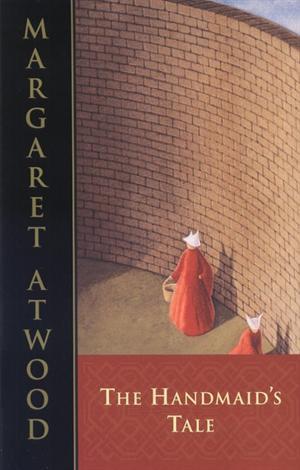
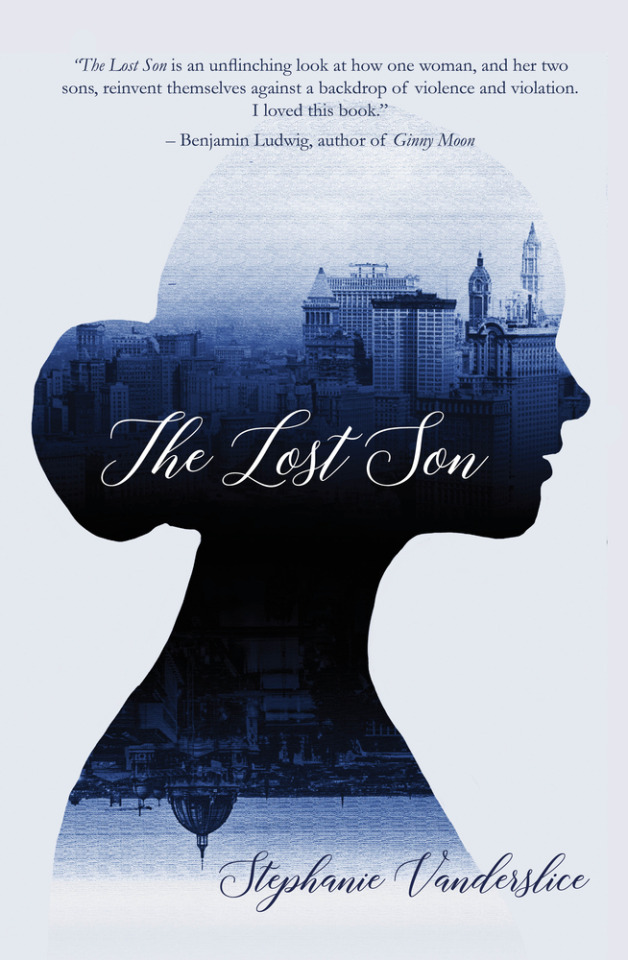

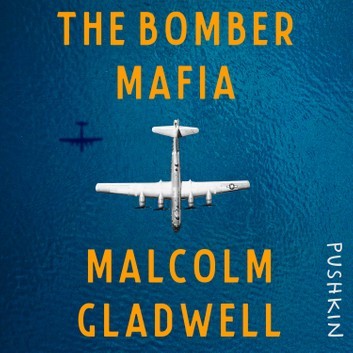


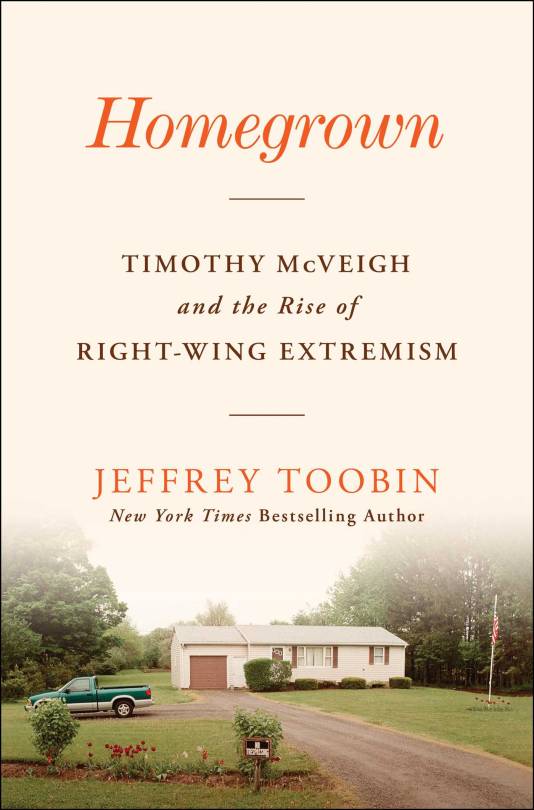
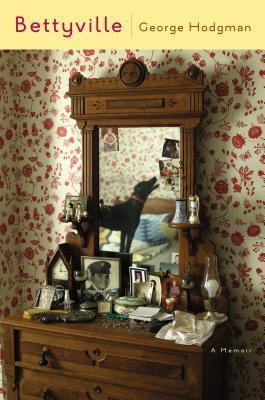
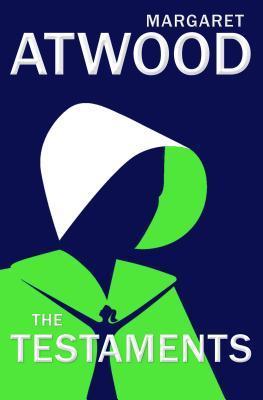
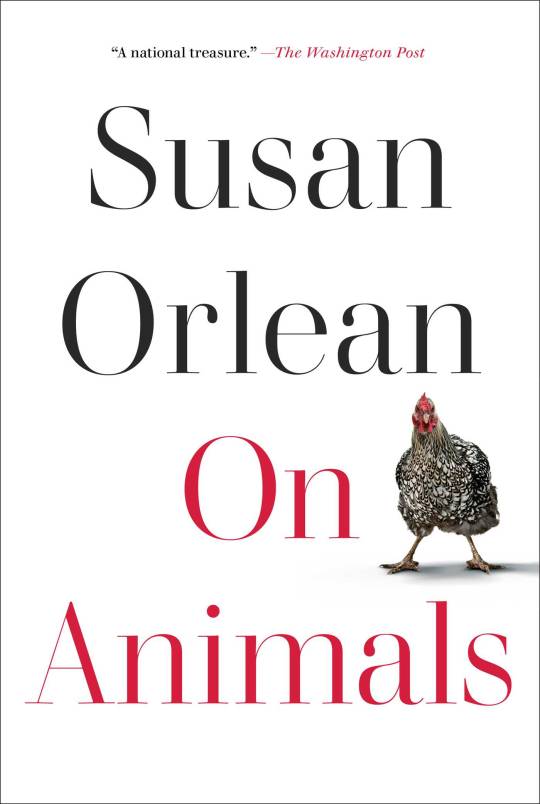

I read 25 books this year, nine of which were fiction. I went down a Malcolm Gladwell hole (that I thought I'd already been down) for a bit, and I read a few good books written by friends, but it's worth noting that I would gladly lose friends before I put a book on this list that didn't deserve to be there. Here were my top 11, ranked in the order that I enjoyed them:
The Handmaid’s Tale by Margaret Atwood (1985)
A perfect futuristic dystopian novel in that it feels like a such a real-world possibility and doesn't overlook the finest of details -- the obvious ones, as well as the subtle ones. I'm eager to pick up the next one.
2. The Bomber Mafia by Malcolm Galdwell (2021)
A fascinating perspective on the advancement of air power and bombing in the years leading up to (and during) World War II. As with most honest war stories, there is no clear good and evil after digging beneath the surface, and Gladwell does a phenomenal job of digging. I highly recommend the audiobook because of the use of recorded interviews.
3. The Tipping Point by Malcolm Gladwell (2000)
Somehow I accidentally deleted my review of this one and now I'm going to lose sleep over it. What I remember, seven months after reading it, is that I'm a connector and I need to collaborate with mavens if I really want to get an idea off the ground. And also that I should be pushing Blues Clues onto my children, even though I'm a die-hard Sesame Streeter.
4. The Lost Son by Stephanie Vanderslice (2022)
I struggled with the back and forth in time and place at first — as I normally do — but settled into it after the first 50 pages, when the narrative takes off. A good gut-punch will tether you to a story no matter where it goes in space and time. In this book, Vanderslice gives us a solid World War II family drama that pulls especially hard on the ties that bind siblings to each other, and parents to their children. I finished this one with a quiet, snotty cry next to a stranger on an airplane.
5. Outliers by Malcolm Gladwell (2008)
Gladwell tells a good story and I'm a big fan of debunking the myth that "genius" alone leads to success -- one also needs resources and the luck of generational timing. As a dad, though, my major takeaway is that my kids should be going to school year-round.
6. The Testaments by Margaret Atwood (2019)
I appreciated the distance in perspective from what Atwood gave us in The Handmaid's Tale. I especially enjoyed Aunt Lydia's perspective and the story of her indoctrination. As the three narratives drifted closer together, I found myself eager for further development of the tale instead of hearing the same tale from different points of view. Still, this should be required reading for the contemporary age.
7. Bettyville by George Hodgman (2015)
Hodgman pieces together vignettes that seem at times unrelated to the next or the last, but he somehow manages to weave together a narrative that is as complete as one can hope. The relationships he gives us are at once sad and humorous, and painfully true when it comes to hiding our fears from the ones we love. This book is ultimately a declaration of the love and forgiveness he has for his mother. And ultimately, oddly, it's also a demonstration of the love she has for him.
8. Crying in H Mart by Michelle Zauner (2021)
This memoir written about a time of sorrow and unknowing follows the writer's exploration of her memories and she applies them to her present day in that common humanistic attempt to make sense of it all. The journey of this book feels authentic, especially because Zauner provides a fantastic soundtrack through Japanese Breakfast that corroborates and reiterates the feelings in the book. She has so much love for her mother and it comes through. (Also, I want to go to Korea and eat all the things now.)
9. Homegrown by Jeffrey Toobin (2023)
It's amazing that we (and Toobin) have access to so many pieces of evidence of McVeigh's life. This book feels exhaustive, but I was glued to everything right up until McVeigh goes into custody. The early sections of the court case got a little dry, but keeping those sections were the right editorial choice because it showed the excessive expenses associated with his defense. Toobin lured me back in. My wife was glad when I finished this one because I finally stopped coming home and saying, "Back to Tim McVeigh -- GET THIS!" and launching into what I learned about him/the case. The whole thing is fascinating.
10. On Animals by Susan Orlean (2021)
An interesting look at how humans interact with various animals in a specific time and place, but also throughout history. Well researched, but full of warm language. A plethora of interesting tidbits to share with the wife (that she doesn't really care about probably, but she humors me and listens).
11. We Hold Our Breath by Micah Fields (2023)
Though I've visited a half-dozen or so times, Houston has never had a definable personality for me. I appreciated the personality of the city Fields gives us here, but his real accomplishment is the portrait he provides of his imperfect mother. It's in how he writes honestly about her flaws that we see the love he has for her. That's not easy to do.
Previous Book Lists: 2022, 2021, 2020, 2019, 2018, 2017, 2016, 2015, 2014, 2013, 2012, 2011.
#book lists#books#reading#best of 2023#2023 books#malcolm gladwell#a handmaid's tale#margaret atwood#stephanie vanderslice#micah fields#michelle zauner#jeffrey toobin#george hodgman#susan orlean
0 notes
Text
Kikori no Yosaku
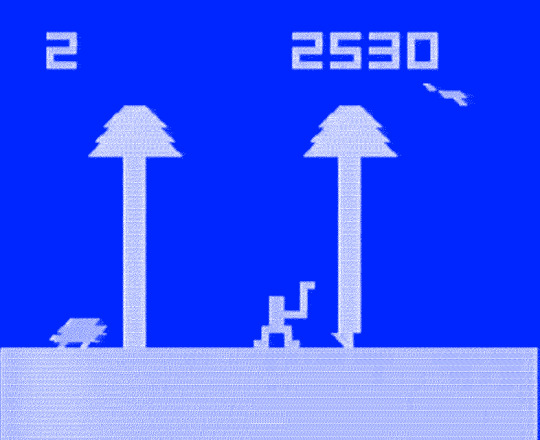
ヘイヘイホー ヘイヘイホー
「hei hei hou, hei hei hou」
You're probably never going to play Yosaku. Nobody will. It appears only in scant screenshots, an arcade flyer, mention in SNK 40th Anniversary Collection, as an easter egg in The King of Fighters: Battle de Paradise, and demonstrated in a single YouTube video. Releasing shortly before Safari Rally and Ozma Wars, Yosaku remains undumped (if not entirely lost) alongside SNK's earliest 'Micon Kit' Breakout clones. In spite of its obscurity, Yosaku is a foundational game not just for SNK, but for the early Japanese games market as a whole.
ヘイヘイホー ヘイヘイホー
「hei hei hou, hei hei hou」
The premise of Yosaku is pretty simple. The player is a lumberjack, toiling away in the forest while branches fall, birds defecate, boars charge, and snakes slither. Avoid danger, chop the trees, get a high score. It is by no means groundbreaking but for a 1979 release it seems to be decently fun. What is fascinating about Yosaku stems from what inspired it: an Enka song popularised by Saburou Kitajima in 1978.
トントントン トントントン
「tontonton, tontonton」
One of Sabu-chan's most famous works, Yosaku similarly tells the basic tale of the titular Yosaku chipping away at a tree while his wife performs domestic duties. Written by religious scholar and critic Kiminori Nanasawa, Yosaku was a submission to the long-running NHK musical variety show Anata no Melody. The conceit of the program was that amateur songwriters would submit their work to be performed by professional musicians. Yosaku's sparse lyrics are abound with onomotapoeia, and it's just a great track overall. In fact, the game Yosaku features part of the melody of the song Yosaku as sung by Sabu-chan, and it's officially licensed from the Japanese Society for Rights of Authors, Composers and Publishers, one of the first video games to bear their legal blessing.
トントントン トントントン
「tontonton, tontonton」
Lest we forget, this was the era of the arcade clone. Perhaps in a cruel twist of irony then for a company founded on Breakout clones, Yosaku is known less for its arcade release, and more for the unlicensed, unsanctioned copycat which released at the launch of the Epoch Cassette Vision. Kikori no Yosaku sees the detailed SNK original reduced to its barest geometries and most base elements. The much chunkier graphics reduce the playfield to just two trees instead of Yosaku's three. Unable to litter the space with smaller but more plentiful hazards, Kikori no Yosaku's dangers are the unhewn log to Yosaku's two-by-four. Rather than allow Yosaku to hide behind trees, Epoch's version leaps over boars. And even without the legal go ahead, Kikori no Yosaku has a crude rendition of those same bars from Sabu-chan's hit song.
ホーホー ホーホー
「houhou, houhou」
The Epoch Cassette Vision held 70% of the games console market in Japan by 1982. 'Video Games Console Library' makes the unsubstantiated claim that Kikori no Yosaku was the game that made the Cassette Vision as successful as it was. It's impossible to concretely corroborate this, but considering it was a launch title (and labelled as #1), it would certainly have drawn some customers in. Furthermore, Cassette Vision game releases were glacial, being made in-house by only three developers with a new title hitting shelves every quarter. An interview with Epoch designer and supervisor Masayuki Horie similarly asserts that Kikori no Yosaku is the first game people talk about when the Cassette Vision is discussed. Horie mentions that industry shows saw developers trying to discern which games would be popular, and thus fit for cloning, so Kikori no Yosaku's significance may well be true.
ヘイヘイホー ヘイヘイホー
「hei hei hou, hei hei hou」
With such a storied past, one might want to play Kikori no Yosaku for themselves. Well, you're probably never going to play the Cassette Vision release of Kikori no Yosaku, and not for lack of trying. A key quirk of the Cassette Vision is that the console itself is effectively just an AV passthrough. It lacks a processor. Unlike with other cartridge-based systems, Cassette Vision games house the software and hardware which allowed vastly faster operation. This means emulation is, while not impossible, entirely too cumbersome for anyone to have meaningfully tackled it thus far - ROM dumps for all eleven releases do now exist at least. Barring the purchase of antiquated hardware, Kikori no Yosaku is just as playable as Yosaku.
ヘイヘイホー ヘイヘイホー
「hei hei hou, hei hei hou」
Or so I thought. As it turns out, an unofficial port of Kikori no Yosaku came to the Sharp X68000 in 1991 thanks to IJI Team. This clone of a clone is a near-exact recreation of the Cassette Vision original, down to the graphical quirks of diagonal sprites. The only substantial difference I was able to spot has to do with the colours themselves, which are more pastel on Cassette Vision than they are on X68000 - this may be due to the oddities of RF connections.
トントントン トントントン
「tontonton, tontonton」
All told, Kikori no Yosaku is a pretty fun romp, albeit a pretty easy one when not playing on the higher difficulties. The circumstances of its creation as a clone of an oddly seminal title, which itself is only accessible thanks to another clone, make it noteworthy. Furthermore, the X68000 version is the only such recreation of an Epoch Cassette Vision game. Even the absurd Pac-Man clone PakPak Monster remains bound to the original hardware.
トントントン トントントン
「tontonton, tontonton」
Yosaku is a hit enka song written by an obscure amateur.
Yosaku is one of the only lost SNK titles.
Yosaku is one of the first games to have music licensed by JASRAC.
Yosaku is perhaps responsible for the success of the Epoch Cassette Vision.
Yosaku is emblematic of the wild west of early video game (non)copyright.
Yosaku is a chunky, shameless copy.
Yosaku is a near-perfect recreation.
Yosaku is simple but elegant.
ホーホー ホーホー
「houhou, houhou」
0 notes
Text
Okusama wa Majo
Bewitched is a 1964 sitcom about a witch named Samantha who marries a human named Darrin and tries to give up magic for him but can't quite seem to quit. It could be argued that Bewitched is a magical girl show given that Sam is the main character and her magic is an important part of the plot. However, whether or not the show itself is magical girl, it has an interesting place in the history of the genre.
A well-known bit of trivia is that Bewitched was a point of inspiration for Sally the Witch, the first ever magical girl anime, which began airing in 1966. Earlier that same year, Bewitched had started airing in Japan under the title of Okusama wa Majo (which literally translates to My Wife is a Witch), and it became quite popular with young girls. Japanese love for Bewitched didn't end in the 60s either. A Japanese-made reboot of the show aired in 2004, also titled Okusama wa Majo, and the name was spoofed in the title of the 2005 magical girl anime Okusama wa Mahou Shoujo (or My Wife is a Magical Girl). Most relevant to this blog's subject matter, during its original run Bewitched was adapted to manga not once, not twice, but three separate times.

The first of these manga was published in the now-defunct Shoujo Friend in 1967 and was created by Yasuko Aoike. Aoike is notable for being a member of the Year 24 Group, a group of female manga artists who were hugely influential in the medium in the early 70s. Aoike in particular is known for writing gay romance, such as her most well-known work, From Eroica with Love. Sadly, I couldn't find much information about her work on Okusama wa Majo aside from a small handful of scattered pages, not even an exact chapter count or publication dates. The preliminary timeline I drew up before starting this blog lists this manga's start date as March 21, 1967, but I cannot for the life of me remember where I pulled that information from, nor can I find anything to corroborate it now, so take it with, frankly, an entire salt lick.

1967 also saw the serialization of a manga by Masako Watanabe in the then-weekly shoujo magazine Margaret. The Margaret version has been chronicled online in surprising detail. A total of 9 chapters were published, starting with issue 32 (published July 23, 1967) and ending with issue 40 (published September 17, 1967). This iteration of the manga seems to be the most well-remembered, at least in the sense that it is the subject of more online discussion than the other two and it has by far the most surviving scans, as well as being the only manga mentioned on Bewitched's Japanese Wikipedia page.
Watanabe is another influential creator in the realm of shoujo manga from this time period. In addition to more traditional shoujo, she dabbled in everything from horror to erotica. In the sixties, however, she wrote a number of stories focused on mother-daughter relationships. It makes sense then for her to adapt Bewitched given the focus not only on Samantha's relationship with her mother, Endora, but also with her own daughter Tabitha.

Lastly, a version of Okusama wa Majo ran in Nakayoshi and, interestingly enough, this was the only one to get printed outside of its original magazine run. It was published as a single tankobon volume on February 1, 1968. I say "interestingly enough" because this version seems to have the least available information online. In addition to being unable to find the number of chapters or dates it was originally serialized in Nakayoshi, I can't find much information about the mangaka, Kiyoko Takenaka, either. I couldn't find a singular profile of her work anywhere, and this Bewitched manga seems to be one of the most well-remembered things she ever created. Which is saying something considering how obscure it is.
Sadly, I haven't been able to read any of these for myself. They've all been out of print for decades and I haven't found anything to suggest they were ever translated in any capacity. All I've found is scattered untranslated page scans supplemented with some low quality photographs. Like I said, Masako Watanabe's take on the series seems to be the most well known, and even then I wasn't able to collect a complete chapter. As such, I can't accurately say how these manga compare to the source material. But I can certainly make some educated guesses.
One thing that's worth noting is that across all three manga, Samantha seldom seems to be centered as a singular protagonist. She's definitely the main character, but in the pages I have access to, she is rarely on her own. There's lots of her loving Darrin unconditionally, lots of her caring for baby Tabitha, lots of Endora being Endora, and all of this feels very much in the spirit of the show.
Something that does not seem to have carried over from the show is the impetus to refrain from magic. In the original series, Sam's goal is not to do magic but to resist doing it. This, I think, is one of the major reasons people are often hesitant to call Bewitched a magical girl show. Yes, she gives in to the temptation to cast spells more often than not but she's still not supposed to. By contrast, I didn't see anything in any of these manga that would indicate Sam is trying to curb her magical tendencies. Mind you this is hard to confirm definitively without a full understanding of the dialogue and with huge swaths of the manga still missing. The only times she seems a tad cagey around using magic is when Endora does so in public where others might see. This implies that they are still nominally supposed to keep the fact that they are witches a family secret, which makes total sense.
It's a shame these manga aren't more well-known because from what I could find of them, they're all quite nice. Their connection to a series that has so much influence in the inception of the magical girl genre already is really fascinating, and they make for a great early entry in the genre.
#my posts#long post#Bewitched#Okusama wa Majo#奥さまは魔女#Yasuko Aoike#青池保子#Masako Watanabe#わたなべまさこ#Kiyoko Takenaka#竹中きよこ#Shoujo Friend#Margaret#Nakayoshi#live action#western source material#60s#shoujo
182 notes
·
View notes
Text
Indeed, the very notion of atrocity, of war crime, is associated with the expectation of photographic evidence. Such evidence is, usually, of something posthumous; the remains, as it were–the mounds of skulls in Pol Pot’s Cambodia, the mass graves in Guatemala and El Salvador. Bosnia and Kosovo.
And this posthumous reality is often the keenest of summations. As Hannah Arendt pointed out soon after the end of the Second World War, all the photographs and newsreels of the concentration camps are misleading because they show the camps at the moment the Allied troops marched in. What makes the images unbearable–was not at all typical for the camps, which, when they were functioning, exterminated their inmates systematically (by gas, not starvation and illness), then immediately cremated them. And photographs echo photographs: it was inevitable that the photographs of emaciated Bosnian prisoners at Omarska, the Serb death camp created in northern Bosnia in 1992 would recall the photographs taken in the Nazi death camps in 1945.
Photographs of atrocity illustrate as well as corroborate. Bypassing disputes about exactly how many were killed (numbers are often inflated at first), the photograph gives the indelible sample. The illustrative function of photographs leaves opinions, prejudices, fantasies, misinformation untouched. The information that many fewer Palestinians died in the assault on Jenin than had been claimed by Palestinian officials (as the Israelis had said all along) made much less impact than the photographs of the razed center of the refugee camp. And, of course, atrocities that are not secured in our minds by well-known photographic images–the total extermination of the Herero people in Namibia decreed by the German colonial administration in 1904; the Japanese onslaught in China, notably the massacre of nearly four hundred thousand and the rape of eighty thousand Chinese in December 1937, the so-called Rape of Nanking; the rape of some one hundred and thirty thousand women and girls (ten thousand of whom committed suicide) by victorious Soviet soldiers unleashed by their commanding officers in Berlin in 1945–seem more remote.
–Susan Sontag, Regarding the Pain of Others
26 notes
·
View notes
Text
for the sake of accurate portrayal, i (hastily) compiled all text currently known/assumed to be gaster speaking. i thought this might be useful for anyone else looking to write dialogue for him, or for anyone else interested.
you can take a look at this compiled dialogue HERE!
i have a few notes on all this too, which i hope are useful as well.
Gaster speaks exclusively in caps, the only instance of him using lowercase at all is in the [redacted] room, and it’s likely he’s not directly speaking there
He never uses contractions
His dialogue is typically separated with line breaks, pauses, or periods. (During Deltarune’s intro, there will occasionally be a pause lasting a second or two between words.) He uses commas on a few occasions, especially throughout Deltarune’s announcement
Has a tendency to stop and starts sentences suddenly
He often words things strangely (”IT WILL BE SUBSUMED”, “YOU ACKNOWLEDGE THE POSSIBILITY OF PAIN AND SEIZURE", etc.)
Doesn’t actually have many examples of talking in Wingdings—the vast majority of his dialogue is just plain text. Aside from entry #17, the only other time we’ve seen Wingdings being used is from images on Deltarune’s website prior to its release
Speaking of those images, he MIGHT NOT use apostrophes?? “him.png” says, when translated, “THREE HEROES APPEARED / TO BANISH THE ANGEL S HEAVEN”. There’s definitely a space replacing the apostrophe. Very small, weird detail
Tends to speak very politely—the Japanese translation corroborates this, in which he uses very formal language. Notably, his language in entry #17 is more informal [source]
He says the word 'VERY' a lot, and “VERY INTERESTING” seems to be a catchphrase
Possibly uses spaces before exclamation points? Only example of using exclamation points so far comes from Deltarune’s announcement, probably just a stylistic thing but I think it’s a cute detail to note
Probably doesn’t use an asterisk before dialogue. The only exception to this is the [redacted] room, again
479 notes
·
View notes
Note
You talk a lot about how the Digimon are born from the kids own souls, would you be interested into describing how the digimon partners reflect their humans' personalities?
Oh man, I love this topic! (You’ll have to forgive me in that my desire to do justice for it is why it ended up taking me this long to answer it.)
The part about the Digimon literally being part of the kids’ souls comes directly from official (it’s been mentioned several times, not only in what I just linked). This was never stated outright in the original Adventure or 02, and it took until Kizuna to really shove the link between the partner and the human’s inner self in your face and make it a huge part of the actual story, but fans had been catching onto it long before that, and even without reading what the staff had said. Kizuna throws a bit of a nail in this because it’s said to be a bit lore-noncompliant, but considering how much of the background lore it still goes out of its way to adhere to, and the fact it still does match the fundamental concept of “human heart = Digimon partner” regardless of detailed minutiae, we can still apply and analyze this concept with no problem, especially since Adventure and 02 always walked the line between sci-fi and fantasy, and there is undoubtedly a spiritual element to them no matter how you look at it.
(My personal comfort zone in analyzing Adventure and 02 comes moreso from a human behavior and mentality perspective, which is also why my meta on this blog tends to focus more on the human drama aspects of Adventure and 02 and especially the latter’s story being so heavily about human relationships, but if you’re interested in said spiritual elements, I heavily recommend @analyzingadventure‘s very comprehensive meta on Adventure background lore and themes, which also covers similar territory in detail. We’re different people, so our takes on it probably differ in some respects, but that’s the beauty of having different perspectives, after all.)
In any case, back to your question. I think it would be best to break this down piece-by-piece with the Adventure and 02 kids in detail, so more is under the cut!
...Well, okay, before we continue, I do want to touch on something briefly, and it’s regarding the fact that “evolution” in this series is generally a metaphor for human growth. That counts for when everyone gets their evolutions, but it also counts as a metaphor overall -- after all, Adventure is about self-assertion and pushing oneself as far as possible (the major evolution gimmick being tied to Crests), whereas 02 is about cultivating differing aspects of yourself and applying it to how you form relationships with others (the major evolution gimmick being tied to Digimentals and ultimately Jogress). The human self is quite a flexible thing, and the Digimon themselves quite often change personalities as they evolve. (I touched on this briefly in my discussion of honorfiics and first-person pronouns earlier, but in Japanese, the Digimon will often even change personalities and speech patterns as they evolve.) This also leads to a few other potential observations (not really corroborated by official, just my personal view of it):
Speaking from a meta perspective, the fact that only the “front protagonists” end up getting the highest level forms is pretty obviously so they don’t have to spend toy budget on allocating it to everyone, but from an in-story perspective, Adventure episode 50 adds an implication that not reaching as high of a form may also have to do with how inherently attuned one is to combat (Jou says that he believes that Gomamon will never reach Ultimate because he doesn’t have the sort of strength Taichi and Yamato do, and it contributes to his conclusion that his skills are more meaningfully applied as a healer instead of as a fighter). Of course, none of the Adventure or 02 cast is necessarily the belligerent type that inherently likes fighting in itself, but of course certain ones are less emotionally drained or more attuned to it, so you might be able to see a rough pattern there. (Again, I’m not going to sugarcoat how this still has a lot of dismaying issues on the meta level, but the difference between “how much this sucks on a meta level” and “whether this at least tracks in-story” is a common theme on this blog.) In a franchise sense, Digimon were of course conceptualized as fighting monsters, but within the narrative of Adventure, it probably stands to reason that having a manifested part of your soul or inner self shouldn’t necessarily mean they have to be fighting things all of the time unless it’s necessary.
It’s very often been pointed out that the 02 cast is at a sort of “combat disadvantage” compared to their seniors (well, and Takeru and Hikari, anyway) because their highest forms require two people/Digimon to be in play, so their overall combat power is rather low. My impression is that this is by design (and it’s a subversion of the usual expectation of shounen anime sequels where the sequel will often power creep everything to make the new guard outdo the first). That the 02 team is inherently dependent on each other for support, and to a degree far more than their seniors, is rather baked into its narrative, and moreover, from an in-story perspective, the 02 group doesn’t seem like the type to really care about being outflanked by their seniors (on the contrary, they’d probably take that as more proof that their seniors are amazing). Moreover, the forms you see their Digimon in most of the time tend towards the smaller Baby-level forms instead of the Child-level ones, and while this is partially due to plot logistics about being in the real world (and, admittedly, kind of inconsistently applied), it gives you a much stronger impression of the 02 kids and their partners in general being people who aren’t that individually imposing or strong and get more mileage out of flexibility and variety (see: the Digimentals and the huge number of lower-level forms the kids have access to).
With this kind of metaphor, I caution against taking it too literally as a 1:1 thing (especially since official has been generally quiet about it and there isn’t much in the series text itself to corroborate this), but I do think there is certainly some kind of relevance that’s worth thinking about.
Many people, including the official notes I just linked, refer to there being some Digimon partners that are "like-minded” with their partner, and some that are “opposite” in personality. This is roughly true, but I find this to be a very simplified description of the concept; it’s more like all Digimon partners are a reflection of the less easily exposed part of their human partner (and, most pertinently, the part that would allow them to express themselves in ways they wouldn’t normally), it’s just that the kids with more straightforward or less extreme personalities don’t have as much to hide or cover up in the first place, and so their partners come off as more “like-minded”. Even Urawa Megumi, voice of Iori and Armadimon (arguably one of the pairs of partners that seem “opposing” in personality), stated that she didn’t personally feel like the two characters are all that different, since humans have different sides to them, and Armadimon is functionally an expression of the side of Iori that isn’t apparent.
Because the Adventure narrative has the Digimon partners be linked to human mentality, this leads to the side effect that you won’t have a Digimon partner who ever truly denies the human partner (barring external factors like Evil Ring-induced brainwashing), which is something producer Seki Hiromi was quite insistent about. That said, this is a very Adventure and 02-specific thing, since other series go more into different angles about how one would approach partnership when this factor is not in play; half of Tamers’s drama regarding partners comes from the fact they are not necessarily mentally linked all of the time, and need to find a way to build a relationship by bridging that gap, and so non-Adventure universe entries are more freely able to explore the concepts of a Digimon partner more consciously entering conflict with their human partner. Well, that’s the beauty of having a multi-entry franchise, after all.
Taichi and Agumon
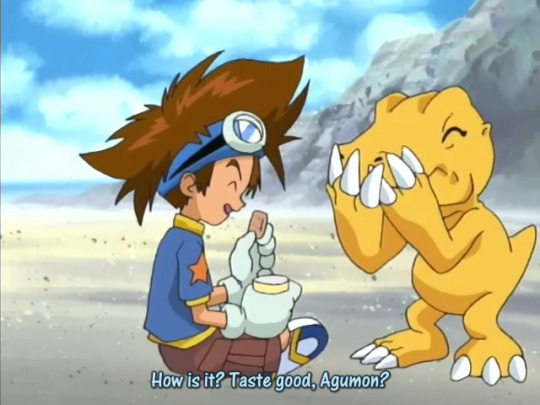
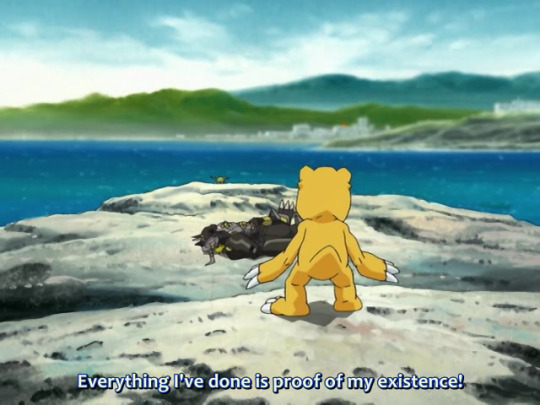
Taichi and Agumon immediately jump to mind as the first among the “like-minded” pairs, especially since the series shows them so often in sync and chilling together. Taichi himself is a straightforward person, so it stands to reason that his straightforward personality would also lend to Agumon coming off as being rather much like him.
However, there is one slight difference between the two, and it’s that Agumon has a somewhat stronger sense of “easygoing chill” than Taichi does, right down to using the more polite boku first-person pronoun in contrast to Taichi’s more assertive ore. He also lacks Taichi’s penchant for mild insensitivity -- in fact, very unlike Taichi, he has an incredible amount of emotional insight (02 spends quite a bit of time in 02 episodes 32 and 46 to showing off Agumon as someone who makes up for all of his lack of intellectual understanding with emotional and borderline poetic insight). And, really, while Taichi is a bit surface-insensitive, and while he seems to be impulsive, he actually is a conscientious person and is trying his best in his own way, and he isn’t the kind of person who cares about societal things like seniority, and he demonstrates multiple times that he’s easygoing and chill, and so you can say that’s a part of Taichi as well. Remembering that a Digimon partner’s presence helps their own human partner grow, Agumon being so openly friendly helps Taichi maintain good relations with others without running afoul of them.
One of Agumon’s most famous traits is that he likes food, which is not actually something that was in the original Adventure or 02 all that much but has been somewhat exaggerated since. That said, back in Adventure, while it was established that all Digimon regularly need food in order to maintain their evolutions, Agumon would usually be the first to complain “I’m hungry,” and whenever they did get food, Agumon would be one of the most prominently enjoying it. Food is, after all, one of the simplest and most universal of pleasures, and there’s a lot of visual framing of Taichi chowing down just as ravenously as Agumon is -- so, honestly, he probably got it from him.
Taichi also speaks a bit about his pain of being separated from Agumon in the space between Adventure and 02, and he directly refers to Agumon as “the other me”. The word “partner” was not actually used very much in the original Adventure or 02, and Taichi is not able to fully elucidate the sentiment of Agumon’s connection to his own self, but he still understands this much and why the loss cuts him so deeply, and by the time we get to Kizuna, it’s presumably why he uses similar language in his thesis proposal to refer to him. (I already covered the circumstances of Agumon’s relationship to Taichi’s existential crisis in Kizuna and how it led to their separation earlier, so I will omit it here for the sake of avoiding redundancy.)
Yamato and Gabumon

This might surprise some people to hear, but I would also pin this as one of the more ostensibly “like-minded” pairs. Gabumon is shy on the surface, but turns out to be quite passionate -- he uses the same assertive ore as Yamato, in contrast to Agumon’s boku, and he demonstrates his capacity for passion and action in that he’s arguably one of the most assertive in the cast. Note his taking initiative against Yamato’s frostbite in Adventure episode 9, or declaring his intent to stay with Yamato even if it means going against the others in Adventure episode 44, or singlehandedly dragging Yamato out of the hole of darkness in Adventure episode 51.
And, of course, Yamato himself is someone who initially seems a little awkward or detached around everyone, but is actually very passionate, so that’s all the same. And because Gabumon himself is so open about communicating with the otherwise closed-in Yamato, Yamato is able to express himself better over the course of Adventure.

Funny thing about that “shyness”, too -- the idea of Gabumon being particularly shy isn’t present in 02 much at all (we don’t get to see him very much, so it’s hard to say whether it’s completely gone, but it’s at least gone enough for the duration of his appearances). Which is funny, considering: guess who else stopped being shy and became naturally outgoing in 02? Yeah, so, as much as you might hear people (even official!) claim that the Digimon are static while their partners change, that’s not completely true -- the Digimon themselves develop in personality in the same way their human partners do. It’s just more subtle and less drastic, since they’re representing an abstract single part of their personality rather than being an exact match.
Sora and Piyomon
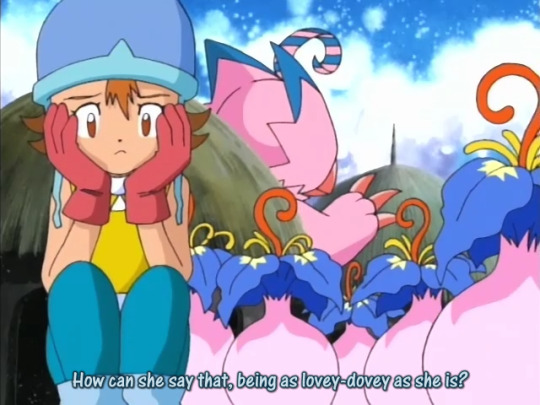
Sora and Piyomon have an interesting relationship in that they’re the only one where their relationship started off on a note of conflict -- mainly in that Sora was very put off by Piyomon at first and even looked down condescendingly on her (well, only for the duration of a single episode). In fact, Sora’s own surface behavior is very different from the kind and caring Sora we know -- Sora dislikes associating with the clingy and affectionate Piyomon for being “mushy”, and even declares that she doesn’t want to “take responsibility” for lugging her around.
Of course, Sora’s character arc later revolves around the fact that she has abysmally bad self-awareness and doesn’t even realize that she has a compulsive sense of responsibility to others. So Sora is affectionate and loving -- she just puts up a front of trying to act a little above that (well, at least, during this part of the series) and doesn’t even see herself as someone capable of being like that (again, purely during this part of the series).
Piyomon is also interesting in that she has one of the most dramatic personality shifts even as early as Child to Adult, where she suddenly switches from the casual atashi to watashi (sometimes even kono watashi, which is super regal), and becomes incredibly dignified and regal even as Birdramon, and you can certainly see why Sora immediately started taking her seriously thereafter. It also begs a lot to think about, considering Sora’s very convoluted character and the many layers of herself that even she isn’t consciously aware of.
The way Piyomon helped Sora shift her own mentality is pretty directly handed to you on a plate in Adventure episode 26 -- because Piyomon played the role of Sora in the metaphor of Sora’s behavior towards Piyomon correlated to Toshiko’s behavior towards Sora, Sora was able to re-adjust her position relative to her family and consider her both someone capable of love, and someone who is loved.
Koushirou and Tentomon

Koushirou and Tentomon are another pair that initially seem like they’re opposing types, with Koushirou being constantly curious and Tentomon being comparatively simple-minded, but the first key to figuring out where the similarity is ends up being a bit deceptive -- Tentomon says in Adventure episode 5 that he’s not particularly interested in himself. And, certainly, Koushirou is interested in Tentomon, but he, too, is not interested in himself -- in fact, he considers himself to be a topic he’d rather avoid instead of looking into everything else.
As far as language goes, while Tentomon does also use the stereotypically easygoing Kansai dialect, he also specifically uses the polite form, mirroring Koushirou’s own perpetual use of polite language. But unlike Koushirou, who uses it to keep distance from others, Tentomon is in fact very sociable, and is even portrayed as a Digimon who’s conscientious of others and “takes care” of them. And because Tentomon is so openly friendly, he manages to coax Koushirou out of his shell and allow him to think about more complicated things related to his own position in the world that he’d been avoiding.
As Koushirou’s character arc proceeds, we learn that he’s polite not only out of distance but also because he really is a very kind person, and moreover that he does eventually want to open up to others. And the payoff for this eventually comes in 02...

...when he ends up becoming one of the most visible members of the older Adventure cast to appear in the series, checking in on the younger kids and developing into someone capable of organizing and managing people. Hmm, seems familiar.
Mimi and Palmon

This one’s an easy one. Mimi is possibly the most straightforward person in the original Adventure cast -- well, that’s the point of her Crest after all -- and so Palmon is almost exactly like her, being a cheerful type who loves being cute. Any contrast between them is only really apparent in the very early episodes of the series, and that’s not even a contrast in theory as much as it’s just something that might intrigue audiences at first when Mimi spent a lot of those episodes complaining, but that’s also mostly because she was heavily under stress, and otherwise Mimi has always been kind and cheerful and indulgent in being cute.
Perhaps the only real difference is that Palmon, being a plant, is more willing to get involved with dirt and other things that Mimi ostensibly would rather not, but as the series progresses, Mimi manages to gain a higher sense of tolerance and get past her initial sense of materialism (which is something she’d had the capacity for the whole time).
Jou and Gomamon

Of the Adventure pairs, this one is probably the one that seems like the biggest contrast on its face, with the overly high-strung and constantly stressed Jou, and the more playful and relaxed Gomamon.
In the end, Jou is someone who’s defined by his desire to support others, and even admits at the end of the series that he’s better suited for a support role than for fighting, and that there’s nothing wrong with that as long as he continues to channel his desire to help people in a way he’s most comfortable with. So, in the end, he’s not actually an inherently aggressive type. And, meanwhile, Gomamon is the kind who’s constantly looking out for Jou, to the point of knowing (such as in Adventure episode 7) when he’s about to do something phenomenally stupid and minding him so that nothing bad happens to him, and so, this is probably why they’re ultimately able to settle down and end the series eye-to-eye (or perhaps hand-to-hand).
And, again, recall that Digimon partners generally reflect a part that’s vital to their own human partner’s growth; considering that Jou is most certainly one of the more extreme personalities in this cast, you get the feeling that he probably needs someone this chill to keep his massive stress tendencies in check.
Takeru and Patamon

Takeru and Patamon are an interesting case largely due to the two of them being so present for a whole two series. In Adventure, both of them seem to be largely like-minded, being playful, innocent, and childish -- although Patamon is more open about expressing the childishness that Takeru keeps trying to cover up. Patamon being roughly on the same playing field (no pun intended) as Takeru means that Takeru has someone he’s willing to be open with and let himself loose a little (such as in Adventure episode 12), because for the first half of the series, he’s almost entirely in the presence of elders and stifling himself for the sake of being “well-behaved”, and it starts his long journey of being able to understand his position and his actual sense of emotions over the course of Adventure and 02.

Patamon also has a striking personality change upon evolving, becoming the regal and dignified Angemon, and, interestingly, his appearances have a very “knight templar” vibe where he takes a no-compromise stance against dark forces and states that he’ll condemn all of them to oblivion. This is a stance that’s unnervingly similar to Takeru’s own no-compromise stance against the darkness in 02, and it’s interesting in that Takeru himself had been advocating for pacifism in Adventure episode 12, but this incident traumatized him enough to start taking a position that more resembled Angemon’s.

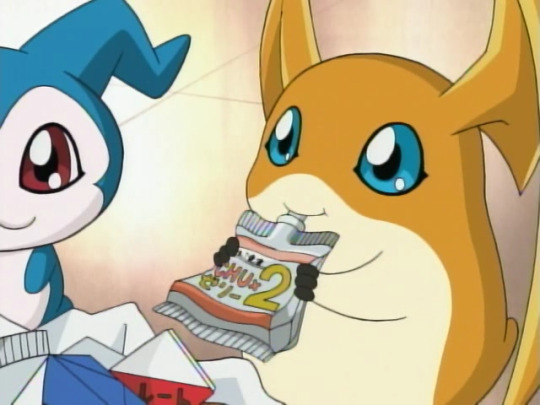
As we go into 02, Takeru’s contrast with Patamon initially seems like an increased mismatch, since Patamon is still ostensibly childish and playful while Takeru is ostensibly more mature. But for one, Takeru’s character arc is about the fact that he’s still pretending he’s more in control of his emotions than he actually is, and in some way you can also glean that there’s a sort of naivete present in his character that he keeps covering up with confident smiles. Patamon, for his part, does actually seem to have adopted a bit of a mentor role to the other Digimon, and we also learn that he’s capable of deliberately trolling people instead of just being generically playful -- much like Takeru himself, who’s a bit evasive and not entirely honest.
We do actually see Patamon reach HolyAngemon in 02 episode 34, but it doesn’t work out well, and while this is partially for plot mechanic reasons, it also says a lot that the “knight templar” stance that both Takeru and HolyAngemon have, with the full depth of no-compromise, isn’t going anywhere, and in the end, something more effective is only possible when Shakkoumon appears in 02 episodes 36-37 -- that is, Takeru is only able to better move on with Iori’s support.
Hikari and Tailmon
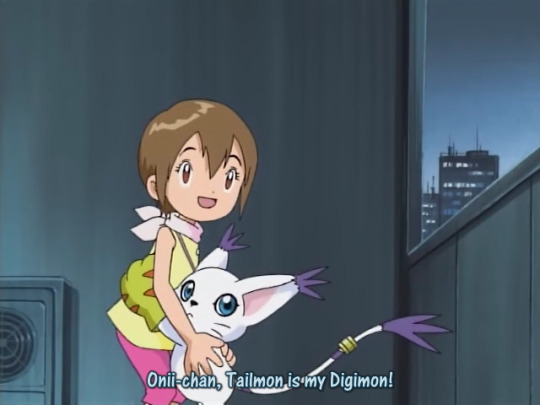
Hikari is the only of the Tokyo Chosen Children to have a Digimon who “defaults” to Adult instead of Child or lower, and it means that Tailmon herself comes with a certain amount of maturity -- on top of having been become a bit hardened due to her experiences being isolated. This is an ostensible contrast to the more pure-hearted and innocent Hikari, but note that Hikari’s own will can be pretty assertive when it comes down to it. On top of that, as much as Tailmon is a bit standoffish, Hikari is also “emotionally isolated” -- she has trouble vocalizing her negative feelings, and it’s difficult for anyone in Adventure or the first half of 02 to truly connect with her internal thoughts. Recalling that the Digimon partner reflects a side of the human partner that’s less easily exposed and allows the human partner to grow in ways they wouldn’t before, Tailmon’s sheer presence gives Hikari a route to action in ways she probably wouldn’t have beforehand.

In 02, Hikari becomes a little more mischievous and playful, and Tailmon also becomes a bit more willing to indulge (she even switches first-person pronouns in sync with Hikari, going from the more polite watashi to the more casual atashi). Both of them are now more able to enjoy themselves more openly. That said, Tailmon still has a certain degree of stuffy personal pride (she snarks at everyone quite easily for fussing over snacks in 02 episode 3), and Hikari herself remains emotionally elusive and repressive at the start of this series.
Tailmon evolves temporarily to Angewomon in 02 episode 13, which is the first time anyone (in this case, Takeru) makes some degree of headway to reaching out to her and allowing her to open up a bit more, but it’s not until 02 episode 31 when Hikari is fully reached out to via Miyako, which marks the first appearance of Silphymon.
Daisuke and V-mon


Now here’s a very like-minded pair, even more so than Taichi and Agumon -- and, after all, Daisuke is simple-minded, so painfully simple-minded that he’s practically incapable of hiding anything, and so V-mon is almost exactly like him, down to using the same ore pronoun and being feisty and mischievous (a point is also made that he plays soccer with Daisuke, something that Agumon didn’t necessarily do with Taichi), and, heck, in a rare show of Digimon-Digimon crushes, has a crush on Tailmon in the exact same way Daisuke has on Hikari. (By the time we get to Kizuna and its higher animation budget, a lot of attention is paid to having even their body language mirror each other.)
There is only one real functional difference between the two in disposition, and it’s that V-mon is very straightforward, friendly, and kind, without being prone to getting angry or spiteful at anyone, and in the end, it’s indicative of the fact that Daisuke’s tendency to lash out defensively at everyone is just a front -- at his core, he’s friendly, supportive, and kind. Daisuke’s experiences and banter with V-mon contribute to him getting the sort of validation he needed without having to worry about being on edge or lash out defensively, and because of that, he was able to form a healthier and more supportive relationship with the rest of the group.
Miyako and Hawkmon
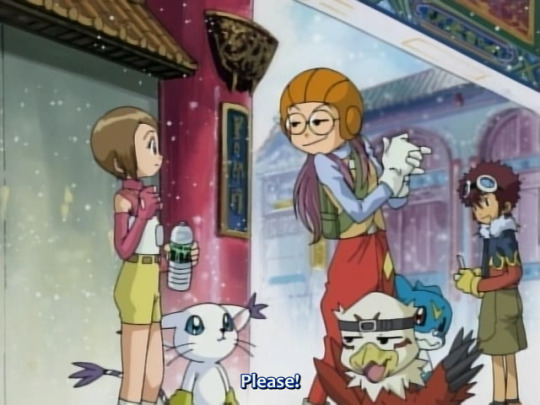
This one seems to be a contrast right off the bat -- Miyako is bubbly, over-the-top, and rather messy and lacking in restraint, whereas Hawkmon is formal, graceful, and polite. But Hawkmon’s most prominent trait is his absolute loyalty and devotion to Miyako -- he’s very often referred to by both official staff and fans as her “knight” -- and is constantly minding her to protect her and make sure she doesn’t go over her head (most prominently, 02 episode 18). And as far as Miyako’s relationship to others goes -- she’s also devotedly loyal to everyone she loves and is constantly going out of her way to help others, and her character arc in itself is about the fact she wants to do her best to reach out to people and help emotionally support them in the best way she can, and Hawkmon managing to channel that to its utmost extent to Miyako in turn (in a very “who watches the watchman?” sense) allows her to regain her bearings and have better control over herself in the aftermath of 02 episode 18.
On top of that, as the series proceeds, it turns out that Hawkmon also shares Miyako’s penchant for dramatic theatrics and being a bit over his head -- even if he seemingly has himself more together than Miyako does, he’s not completely above it all...
Miyako is also the franchise’s first example of a female character with a masculine Digimon partner, and while Miyako herself openly identifies with and indulges in all things hyper-feminine, she also has zero issue engaging in more masculine-associated things as they suit her -- most prominently her Digital World outfit, and the fact she often displays a rather aggressive go-getter and hot-blooded/in-your-face personality that would not be out of place on a male shounen hero in a more conventional show. (Although, as much as these have generally been on the thread of “less visible aspects”, it’s not like this was that less visible of an aspect of her to begin with...)
Iori and Armadimon
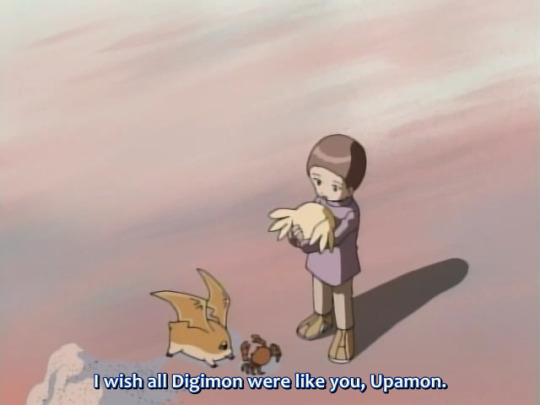
Iori and Armadimon hold the honor of being the only pair in the Tokyo Chosen Children to be voiced by the same voice actress (Urawa Megumi), driving the parallel down even further. And while their surface temperaments seem different, with Iori being rather uptight and strict on himself while Armadimon is laid-back, carefree, and even somewhat assertive, they’re not that different -- Armadimon is basically the curious, impressionable, somewhat childish spirit that Iori would be if he weren’t constantly holding himself back. (There’s a lot to be said about Submarimon going out of his way to take Iori for a ride in 02 episode 16 so that Iori can finally properly enjoy himself for once.)
Iori takes a lot of very stubborn, no-compromise positions over the course of 02, but Armadimon asking just the right kinds of questions allows him to “snap out of it” and be a little more receptive to considering alternatives, or at least taking into account more emotionally-oriented issues he’s dealing with. You can say that Armadimon (especially as Upamon) softening Iori up a bit -- since Iori will never be cold or unforgiving towards his partner, no matter what -- serves as a precursor to Iori starting to question the limitations of his black-and-white view of morality, which allows him to successfully break through to Takeru and fill out the rest of his character arc.
Ken and Wormmon
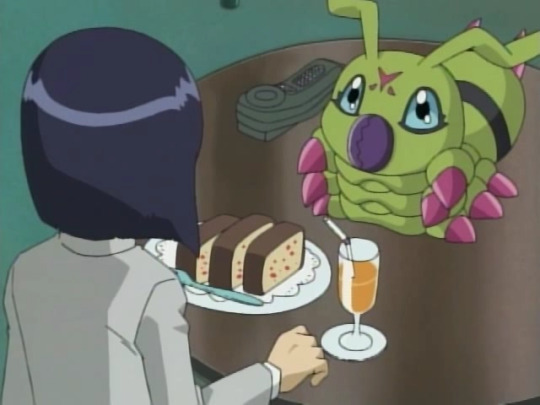
Considering how much of the plot revolved around this one, this one almost goes entirely without saying! During Ken’s stint as the Kaiser, Wormmon represents the heart that Ken’s not entirely willing to leave behind -- and, also, the affection that he’s still craving from his family. The Kaiser going practically out of his way to deny Wormmon yet paradoxically keeping him around is basically his attitude towards his own “weak” and naturally kindhearted self. Notably, recall that the principle of “a Digimon will never deny their partner” applies here -- Wormmon’s “betrayal” of the Kaiser isn’t really any kind of denial, since he was doing it mainly for Ken’s own sake, and, more symbolically, it’s Ken reaching his own limit and coming to realize that this path isn’t what he really wants.
Wormmon is unusually clingy to his own partner over the course of 02, and it’s vital to Ken needing to learn to love himself and also getting important validation that he needs, especially during the critical point in time during 02 episodes 23-30 when he’s still not sure how to approach the rest of the group -- Wormmon gives him someone to talk to honestly and openly, giving him a proper springboard to sort out his complicated feelings about the others and himself. You can say also that as Ken becomes more open and straightforward over the course of the latter half of 02, he, in turn, becomes much more shameless about showing affection and opening his own heart.
Wallace, Gumimon, and Chocomon
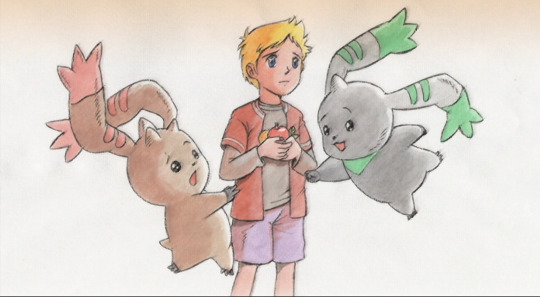
Bonus round!
While it’s hard to fully apply Hurricane Touchdown to this theory (by official admission, it wasn’t properly cross-referenced with the original Adventure/02 series lore, and trying to correlate all of the evolutions in this movie to something metaphorical will give you a headache), Wallace’s two partners still fit very neatly into this overall theory of Digimon partners as a part of the self. Wallace is a character with very sharp duality, trying to be a flirt who asserts himself as a vagrant who’s about to “become an adult”, yet still feels an obligation to keep calling his mom and is engaging in increasingly self-destructive behavior.
Most pertinently, Gumimon and Chocomon represent the two stances Wallace is torn between: wanting to “return to the past” (Chocomon) because he’s still hung up on having lost Chocomon and is convinced that he can make everything just like it was before, and “being able to productively move on” (Gumimon). For most of the early parts of the movie, Wallace is stuck on Chocomon’s mentality of fixating on the past, and Gumimon isn’t even remotely subtle when he draws an explicit parallel between the two (saying that Chocomon didn’t like the heat, followed by offering to give Wallace shade as a hat). But once the conflict escalates and Wallace realizes just how deep in denial Chocomon is, to the point of being destructive to himself and others, Wallace comes to embrace Gumimon’s stance of practicality and moving on. In the end, the ultimate conclusion is reached, and Wallace is forced to fully accept that latter stance when Chocomon dies, but the movie’s ending (and Kizuna) provide an extra option: allowing the past to come back, but in a new form and treading new territory instead of trying to make it “the way it was before”.
#digimon#digimon adventure#digimon adventure 02#digimon adventure last evolution kizuna#kizuna spoilers#qwertyshuman#shihameta#shiha's ask box
200 notes
·
View notes